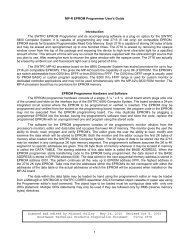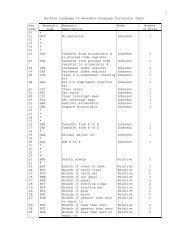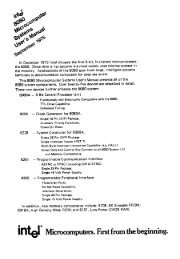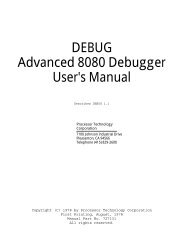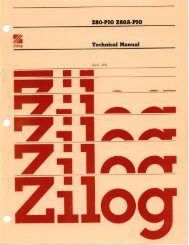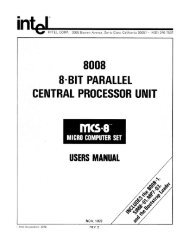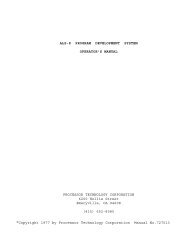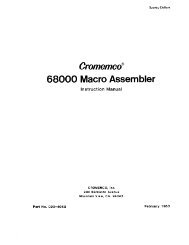The System Manual of SOL-20 - History of Computers
The System Manual of SOL-20 - History of Computers
The System Manual of SOL-20 - History of Computers
Create successful ePaper yourself
Turn your PDF publications into a flip-book with our unique Google optimized e-Paper software.
PROCESSOR TECHNOLOGY CORPORATION<br />
Sol THEORY OF OPERATION<br />
SECTION VIII<br />
Unregulated -16 and +16 V dc, at 1 amp, from the filtered<br />
outputs <strong>of</strong> FWB2 are made available on terminals X6 and X5. <strong>The</strong>se are<br />
not used in the Sol-10, but they are supplied to the backplane board<br />
in the Sol-<strong>20</strong> to drive S-100 Bus modules.<br />
In the case <strong>of</strong> the Sol-<strong>20</strong>, the power transformer (T2) has an<br />
additional 8-volt secondary winding and a third bridge rectifier<br />
(FWB3) to supply +8 V dc at 8 amps. <strong>The</strong> output <strong>of</strong> FWB3 is filtered<br />
by C9 and controlled by bleeder resistor R13. Again, this voltage is<br />
supplied to the backplane board in the Sol-<strong>20</strong>.<br />
Sol-<strong>20</strong> also includes a cooling fan powered by the AC line<br />
voltage.<br />
8.5 Sol-PC CIRCUIT DESCRIPTIONS<br />
8.5.1 CPU and Bus<br />
Refer to the CPU and Bus Schematic in Section X, Page X-15.<br />
A crystal, two inverter sections in U92 and four D flip-flops<br />
(U90) and associated logic make up the Clock Generator.<br />
<strong>The</strong> two U92 sections function as a free-running oscillator<br />
that runs at the crystal frequency <strong>of</strong> 14.31818 MHz. R133 and R134<br />
drive these two sections <strong>of</strong> U92 into their linear regions, and C61<br />
and 64 provide the required feedback loop through the crystal. U77,<br />
a permanently enabled tri-state non-inverting buffer/amplifier, furnishes<br />
a high drive capability.<br />
This fundamental clock frequency is fed directly to the Video<br />
Display Generator and to the clock inputs <strong>of</strong> U90. U90 is a fourstage<br />
register connected as a ring counter that is reset to zero when<br />
power is applied to the Sol. This reset is accomplished with D8,<br />
R104 and C39.<br />
<strong>The</strong> bits contained in the ring counter shift one to the right<br />
with every positive-going clock transition, but the output <strong>of</strong> the<br />
last stage is inverted or "flipped" before being fed back to the input<br />
In a simple four-stage "flip-tail" ring counter, the contents would<br />
progress from left to right as follows: 1000, 1100, 1110, 1111, 0111,<br />
0011, 0001, 0000--on the first through eighth clocks respectively.<br />
<strong>The</strong> hypothetical counter would go through eight states, dividing the<br />
clock by eight.<br />
<strong>The</strong> Sol counter, however, is a modified flip-tail ring counter<br />
that can be configured to divide by one <strong>of</strong> three divisors--5, 6<br />
or 7. This is made possible by using a two-input NAND gate (U91) in<br />
the feedback path and three jumper options (no jumper, D-to-C and<br />
D-to-E) to alter the feedback path. Let's see how it works.<br />
VIII-8



